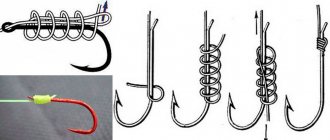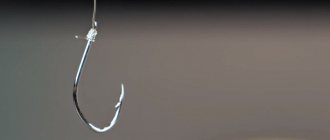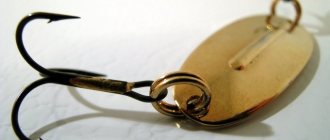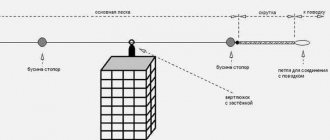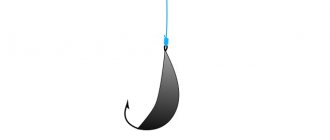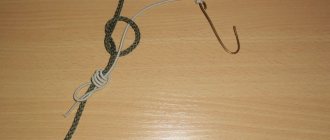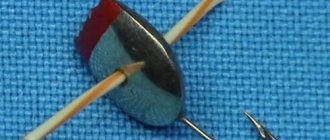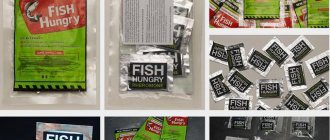How to tie hooks without eyes
This design of the equipment element is intended for cautious fish. The eye and the knot on it are more noticeable in the water than the slight thickening and neat interweaving of the thread at the end of the hook with the spatula. However, heavy active individuals will disrupt this device. You can tie 2 hooks on the main fishing line without an eye in different ways.
Stepped
The knot is difficult to tie, but the tensile strength of up to 95% is worth the effort.
Proceed as follows:
- Fold the working thread in half, attach the hook so that the fold is in the area of the sting.
- With the short free end, wrap the fishing line (one thread) around the shank twice.
- Press the main thread to the forend, use the same tip to make 3 turns, grabbing the forend and now the double thread.
- Thread the end you used to make the turns into the loop and tighten.
Stepped unit
The stepped unit is ready. It can be used on a regular donk, feeder, or spinning rod.
Spiral knot (Dumhof)
If you tie braided lines with a simple knot and without wetting, they will burst at the bend. Elements with blades require a special tying technology so that they do not fall off the line when tensioned.
Of the dozens of ways to knit fishing knots, Dumhof is the simplest variation.
Procedure:
- Wet the thread.
- Fold it in half, attach it to the fore-end and wrap the free end around it 5-6 times.
- Now pull the tip into the loop formed by the bend of the fishing line.
- Tighten the knot.
The result is a strong connection that has a tensile strength of 90-95%.
Your question to an expert
Leonid Grachev
Fisherman with a lot of knowledge and experience
Ask a Question
All types of feeder installations:
Paternoster (Gardner loop)
The Paternoster or Gardner Loop rig can serve as an excellent tool when fishing in any type of body of water (both on a river and in still water).
The Gardner loop is a main fishing line with bait, from which a leash with a weight feeder extends. As a rule, the main line should be of a larger diameter (0.2 - 0.3 mm), and the secondary line should not be more than 0.2 mm.
The main line is folded flush with the thin line and a knot is tied at a distance of 40 cm from the end. The stronger the knot, the better; thin fishing line should not slide along the main fishing line. The Figure Eight knot is ideal.
We cut off one end of the secondary fishing line and shorten the second to 20 cm - we get a leash onto which we knit a swivel with a clasp at a distance of 10 cm. The feeder is attached to the clasp. At the end of the main fishing line we tie a leash using the “loop to loop” method. See how to knit this knot.
In the video you can watch the entire process of manufacturing feeder equipment from Alexey Fadeev .
Symmetrical loop
An installation called “Symmetrical loop” is usually made from fluorocarbon fishing line (diameter from 0.28 - 0.31 mm).
The peculiarity of this installation is that it has a self-cutting function, which is not available in a number of alternative feeder equipment.
The manufacturing process is reflected in the video and diagram.
An important aspect is the nuance that the length of the twisted fishing line together with the loop should be longer than the total height of the hanging feeder on the anti-twist.
diagram “Symmetrical loop”
Asymmetrical loop
The fishing line in this type of installation is recommended with increased sensitivity, so professionals give their preference to fluorocarbon fishing line.
First of all, it is practically invisible, and is also a very durable and poorly deformable material, which affects the sensitivity of the bite.
Installation “Asymmetrical loop” is a modification of equipment with a symmetrical loop with the only difference being that the section of the fishing line on which the swivel with the feeder is located is 2-3 cm longer.
Installation with anti-twist tube (Combine)
diagram with anti-twist tube
Of course, the main feature of this equipment is its ability to prevent tangling and twisting of the fishing line.
Although this type of feeder installation does not have a self-hooking effect, an experienced angler can always achieve greater results with just such a result, because it scares the fish less - it practically does not feel resistance when biting.
Quite simple installation - check out the manufacture of this type of equipment, which can be knitted using either monofilament or braided line.
Inline
The “Inline” installation is very similar to the asymmetrical loop equipment with only one feature: in the inline you can adjust the free stroke length of the feeder
In this case, there is also a section of twisted fishing line near the terminal loop for the leash with bait. It creates a rigid shape that prevents the leash from getting tangled with the fishing line of the rig. The length of this twisted section is approximately 15 cm, which is fixed with a regular figure eight knot.
Helicopter and two knots
Using this installation you can fish both from the bottom and in slightly higher layers of water. Fans of feeder fishing often choose this equipment for catching roach, bream and silver bream.
This feeder equipment is interesting because it is very, very sensitive to fish bite. Works well in fishing conditions with an active bite.
The manufacturing scheme is quite simple.
Tooling Method (Flat Method)
Flat is, first of all, a form of innovative feeder, which has a fairly simple method of attaching the mounting line, as well as such a feature as the ability to distribute the feed itself using tiny air bubbles, which are stored in the feeder while it is charging.
You can see how the Flat Method behaves in water.
Which knitting method should you choose?
Fishing with two or more tools is a special fishing chic. The method is more often used in winter hunting from ice. The importance of the correct knot for equipping a fishing rod with two fishing tools is very large: each connection reduces the strength of the equipment. Therefore, you need to understand that tying 2 hooks to a fishing line, the main one in the equipment, is not a problem, but you lose the reliability of the entire structure.
Although this parameter largely depends on the fishing line itself. Heavy equipment requires quality fiber. Choose a strong braid with high tensile strength. Please note that the cord becomes less durable in water than in air.
The configuration of the rod and the quality of its antennas are also important. Fishing with two or more hooks requires their increased work, so bite alarms must be durable.
However, there are no barriers for experienced fishermen. An active bite and a rich catch compensate for the time spent on knots and the loss when snagging a piece of equipment.
Experienced fishermen will advise which method of connecting two elements of equipment with the main fishing line to choose. They prefer knots with the least amount of kinks: perhaps the Palomar would be the most suitable for equipping a fishing rod with a secondary hook.
Two leashes on a float rod: advantages and disadvantages
Not all anglers accept such equipment. A float rig with two hooks seems like a fad. The second hook on a float rod has its pros and cons .
Advantages of a second hook
Each fisherman chooses for himself how many hooks to use. You won't increase your catch just by equipping your fishing rod with several hooks. It all depends on the experience and skill of the fisherman himself, not to mention other fishing factors that are also of significant importance. Therefore, despite the obvious advantages of this type of equipment, there is no need to quickly remake the equipment; it requires a competent approach and practice.
So, highlighting the advantages of equipping a fishing rod with several hooks , we can highlight the following:
- the ability to attach two different baits,
- stability of hooks in water due to increased weight in conjunction with sinkers,
- increasing the chances of successfully hooking fish,
- lower hook depth,
- the ability to fish at different depths.
Detailed description of all the advantages
When attaching two different baits, it is possible to determine which fish is most responsive to one or another. Sometimes when fishing, the float, along with the equipment and baits, is strongly carried away by the current, and therefore you have to constantly throw the fishing rod to the right place.
When there are several hooks on the fishing line, the total weight of the equipment increases. Thus, in addition to the fact that it is not carried away by the current, it is buried even lower.
If we talk about the third point , which characterizes this method of equipment on the positive side, then it is worth mentioning the increase in the likelihood of hooking fish. This is due to the fact that you can miss the fish when hooking (especially with a sudden movement of the hand) if it has not completely swallowed the bait. If there are two hooks on the line, the chances of catching fish increase.
If you make leashes of different lengths, you can fish at different depths. To do this, use one or more sinkers, which will be located between two leashes. This also increases the likelihood of a catch.
Disadvantages of the second hook
The advantages of the two-hook fishing method do not exclude the presence of disadvantages. Some of these disadvantages can be called situational, that is, they depend on how correctly the leashes were positioned and tied. These include:
- line hook,
- leash breakage,
- entanglement,
- reducing the possibility of “playing” with bait.
Detailed description of all the disadvantages
Now let's look at each of these disadvantages separately. It has already been said that with a double leash there is such a positive aspect in fishing: if one hook gets caught on something, be it some kind of snag or mud, then the other hook will remain with the fisherman safe and sound. But this applies to the case when The leashes on the fishing line are located at a considerable distance from each other. If they are located close enough, then the likelihood that the line will catch on something on the bottom or in the coastal area doubles. Here we can mention another disadvantage, which largely depends on how correctly the leashes are installed.
Close location
If they are placed too close, they can become tangled very easily. Then, instead of enjoying fishing, you will have to untangle the fishing line, and this, as you know, is a rather tedious and lengthy process. Sometimes when the hooks get tangled, you have to cut off part of the fishing line, which leads to the loss of the length of the entire rig. Read below to learn how to position leashes so they don't get tangled.
Nodes
The fact that a node is a weak point has already been mentioned above. Therefore, when there are two or more of them, and this is inevitable in this rigging method, then line breakage can occur more often, especially if the knots are tightly tightened.
And the last minus is the deterioration in the quality of the fisherman’s game with bait. This is due to the increase in weight because there are two leashes attached. Together with the sinkers, this will make playing with the bait somewhat difficult.
How to tie two hooks so they don't get tangled together
To do this, a meter-long fishing line is cut.
Note: This length is arbitrary, it is taken as an example. It is better to choose the length yourself based on the expected fishing conditions.
Then the fishing line is folded in half and a figure-eight knot is tied at one end, thereby forming a small loop. At a distance of about 20 cm from the loop, another figure-eight knot is made (for greater reliability, the end can be passed around the edge several times), wetted and tightened.
You should get one loop with a double fishing line, at a distance of 20 cm from which there will be a knot, and behind the knot there will be two leashes. Now one line is cut between the loop and the knot almost to the very root of the knot, leaving literally 1–2 mm. After this, the hooks are tied, and the loop itself is attached to the main fishing line. The hooks are tied in the usual way: the fishing line is wrapped around the shank several times, the free end is inserted into the eye, and the remainder is cut off.
Due to the fact that the hooks are located at a distance from each other, the likelihood of them getting tangled during the fishing process will be significantly reduced. This equipment is suitable for both float and bottom fishing.
Flaws
We will note the following details as disadvantages:
- The design of such gear loses strength and can fail at any moment.
- The risk of hooks and tangling of equipment increases both when fishing in a strong current and when casting (the wind also has a big influence).
- The rig line becomes more visible, especially in still water.
Reliability decreases by about 20% due to the large number of knots, and by 30% if the fishing line with hooks gets into the water.
Some of the disadvantages listed above can be eliminated. For example, to prevent the threads from getting tangled, lead cambrics are used and the skill of smooth casting is developed. The equipment is camouflaged using fishing lines matched to the color of the water and bottom surface. Only knowledge about the body of water can protect you from snags: where the snags are, where the bottom is, and so on. It’s better to ask local fishermen about this.
How to knit, installation methods
You can tie two hooks to a fishing line in different ways: each angler chooses the more suitable one. There are only four main installation methods, we’ll call them this:
- Zhivtsova,
- basic,
- accelerated,
- stopper.
They are all somewhat similar to each other, but each of them has certain characteristics. Next we will look at another interesting method, few people know about it. He doesn't even look like everyone else.
Zhivtsova
This method was nicknamed “Zhivtsov” because of its original purpose. It is also called no knot because no knots are used to install hooks. Fishermen noted that this method is the most effective when catching predators with live bait (fry). But later people realized: it is also suitable for other fishing conditions. Here both hooks are tied to one leash.
All hooks are on the same line and go one after another. No Knot is well suited for fishing in strong currents.
This is done very simply:
- Let's take the fishing line. We thread it through the eye of the hook.
- We make nine turns around its forearm.
- The other end is also threaded through the ear hook, and the structure is tightened. Similarly, you should tie the second hook to the fishing line. Not a single node! Then we tie the resulting leash to the main cord.
The distance between them depends on the size of the bait and the preferences of the fish being caught. For example, for catfish you can make 10–15 cm, for silver carp or chub - 20 or more centimeters.
Basic
It is considered one of the most reliable. Here, each hook is tied to a separate leash. Why we called it “main”, you will see for yourself. So let's get started:
- We take a thin leader line and one hook.
- We fold the fishing line so that we get a circle with a diameter of 9–10 centimeters. We attach it to the hook and hold it.
- Insert two fingers into the resulting loop: index and middle. With one we will pull the cord along the base of the hook, and with the other we will wrap it 10-12 times.
- We grab the end of the fishing line with our teeth and pull (we try to hold the main end) until the knot is reduced to the maximum.
- After this, dip your fingers in water, and then lubricate the resulting knot with it. You won't be able to tear off or untie the hook! The second hook is attached in exactly the same way, only its leash must be tied at a certain distance from the first one so that there is no overlap.
Why "main". This instruction does not say anything about the eyelet; it does not play any role here. Only the base of the hook is used. This method saves fishing line of any quality from chafing.
The method is very suitable for mounting two hooks on a float rod, since in this case reliability is most important. This gear is often used to catch two large fish at a time, but in this case there is a high probability of the hook coming off, especially if the line frays.
Knitting pattern. The connection must be moistened with water to reduce deformation of the fishing line.
Accelerated
During active fishing, you can observe constant hooks and breaks. Hooks and leashes constantly have to be changed, and this needs to be done as quickly as possible. This method involves not only the simple installation of two hooks, but also the quick replacement of components. That's why we called this method “accelerated”.
To knit the second hook we will use the Canadian figure eight. Like this:
- We thread the end of the fishing line through the ear hook.
- We make a loop around the fore-end, and then insert the tip into the loop.
- We try to tie the knot as tightly as possible. We get a leash with a hook.
- Exactly the same for the second hook.
You can also use a “blind” or “bayonet” knot.
The diagram shows the fastest and easiest methods of tying.
The “accelerated” method allows you to attach two hooks to a float rod in a matter of seconds, even in active fishing conditions. You just need to always take spare parts with you!
Stopper
To install the second hook, it is best to use the knot described above, which is knitted without using an eye. But we attach the leash differently:
- At the empty end of the leash with a hook, we make two figure eights so that we get one massive knot.
- The main cord has a tightening loop, as in the picture.
- We insert our “double” knot into it.
- We take the main line with both hands and pull in different directions.
The knot at the end of the leash acts as a stopper. It prevents the main cord from jumping out of the loop.
